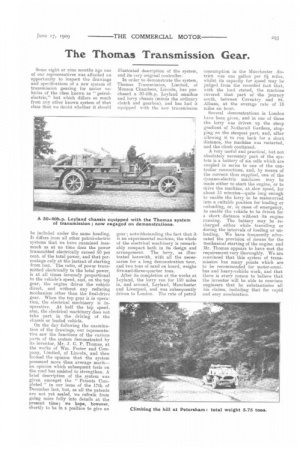The Thomas Transmission Gear.
Page 5

If you've noticed an error in this article please click here to report it so we can fix it.
Some eight or nine months ago one of our represenatives was afforded an opportunity to inspect the drawings and specifications of a new system of transmission gearing for motor vehicles of the class known as " petrolelectric," but which differs so much from any other known system of that class that we doubt whether it should be included under the same heading. It differs from all other petrol-electric systems that we have examined inasmuch as at no time does the power transmitted electrically exceed 50 per cent. of the total power, and that percentage only at the instant of starting from rest. The ratio, of power transmitted electrically to the total power, is at all times inversely proportional to the vehicle's speed, and, on the top gear, the engine drives the vehicle direct, and without any reducing mechanism other than the final-drive gear. When the top gear is in operation, the electrical machinery is inoperative. At half the top speed, also, the electrical machinery does not take part in the driving of the chassis or loaded vehicle.
On the day following the examination of the arawings, our representative saw the functions of the various parts of the system demonstrated by its inventor, Mr. J. G. P. Thomas, at the works of Wm. Foster and Company, Limited, of Lincoln, and then formed the opinion that the system possessed more than average merit— an opinion which subsequent tests on the road has assisted to strengthen. A brief description of the system was given amongst the " Patents Completed ' in our issue of the 17th of December last, but, as all the patents are not yet sealed, we refrain from going more fully into details at the present time; we hope, however, shortly to be in a position to give an
illustrated description of the system, and its very original controller.
In order to demonstrate the system, Thomas Transmission, Limited, of Monson Chambers, Lincoln, has purchased a 3040h.p. Leyland omnibus and lorry chassis (minus the ordinary clutch and gearbox), and has had it equipped with the new transmission gear ; notwithstanding the fact that it is an experimental machine, the whole of the electrical machinery is remarkably compact both in its design and arrangement. The lorry, as illustrated herewith, with all the necessaries for a long demonstration tour, and two tons of sand on board, weighs five-and-three-quarter tons.
After its completion at the works at Leyland, the lorry ran for 150 miles in, and around, Leyland, Manchester and Liverpool, and was subsequently driven to London. The rate of petrol
consumption in the Manchester district was one gallon per ei miles, whilst its capacity for speed may be judged from the recorded fact that, with the load stated, the machine covered that part of the journey south, between Coventry and St. Albans, at the average rate of 16 miles an hour.
Several demonstrations in London have been given, and in one of these the lorry was driven up the steep gradient of Netherall Gardens, stopping on the steepest part, and, after allowing it to run back for a short distance, the machine was restarted, and the climb continued.
A very useful and practical, but not absolutely necessary part of the system is a battery of six cells which are coupled in series to one of the controller connections, and, by means of the current thus supplied, one of the dynamo-electric machines may be made either to start the engine, or to drive the machine, at slow speed, for about 15 minutes—quite long enough to enable the lorry to be rnanceuvreel ieto a suitable position for loading or unloading, or, in cases of emergency, to enable the vehicle to be driven for a short distance without its engine running. The battery may be recharged either while travelling or during the intervals of loading or unloading. We have frequently advocated the provision of means for the mechanical starting of the engine, and Mr. Thomas appears to have met the requirement very thoroughly. We are convinced that this system of transmission has many points which are to be recommended for motor-omnibus and heavy-vehicle work, and that there is every reason to believe that the inventor will be able to convince engineers that he substantiates all his claims, including that for rapid and easy acceleration.
























